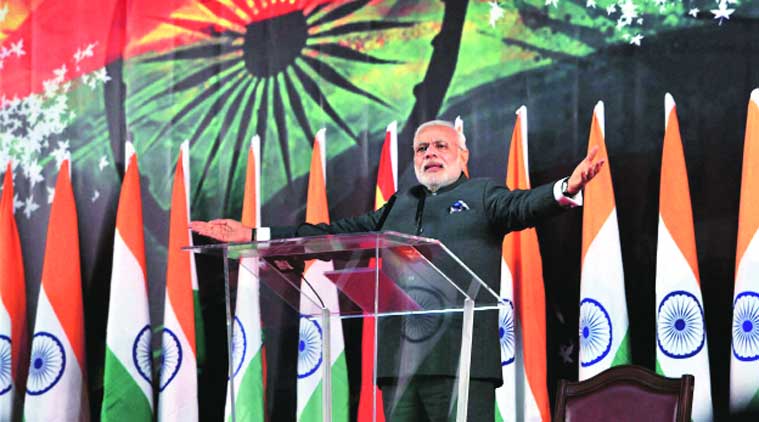Narendra Modi found himself marking a year as Prime Minister neither in his home state of Gujarat nor in New Delhi, but in the bustling metropolis of Shanghai.
The final engagement of his three-day visit to China (May 14-16) was a speech to the expatriate Indian community. I was there and I doubt I shall forget the spectacle. Nor could one argue with his refrain: vaqt badal raha hai (the times are changing).
 Becoming visible
Becoming visible
When I first arrived in China from the UK in 2011, I was struck by how few Indians could be seen there. This impression was compounded by discovering how limited the flight options between China and India were, in great contrast to the daily (often multiple) flights between China and the UK and other more distant destinations. Although business school academics in Shanghai brought together leading practitioners, diplomats and experts to reflect on Sino-Indian business activity, it seemed that neither nation saw the other as much of a priority.
But a lot can (and does) happen in four years. The Modi show in Shanghai certainly suggests progress has been made since I first set foot in China: in the emergence of a new style of foreign relations in India, in the willingness of China and India to engage with each other, in the ability of the Indian community in China to cohere.
As I reflect on this event I am encouraged and cautious in equal measure about China-India relations in general and Sino-Indian business activity in particular, for three reasons.
Prior experience to go with the charisma. My biggest source of encouragement stems from the fact that although this was Modi’s first visit as Prime Minister, it was far from being his first experience of China. Indeed, the one bright spot in my early dismal assessment of China-India dealings was Modi’s visit as Gujarat chief minister in November 2011 — and that had been his fourth such visit.
I teach international strategy in a business school, and I emphasise to my students the importance of prior experience in helping entrepreneurs and managers succeed in foreign markets knowledgably. Modi’s China experience of the past augurs well for what India can achieve in China, and may well make a big difference to whether his visit ends up yielding incremental advances in business opportunities for Indian businesses in China and vice versa — or representing a genuine inflexion point that heralds the next substantial wave of Indo-Chinese commercial activity.
Honest self-reflection
Honesty about problems helps, but doesn’t fix them. My biggest source of caution arises from the fact that the honest acknowledgement of problems is a necessary but insufficient condition for solving them. Modi has been justifiably commended in the Indian press for being frank about the need for tackling vexing issues such as border disputes, and his Chinese counterpart has reciprocated the candour. This helps, but the proof of the pudding will become apparent only as the interfaces established on this visit are utilised for continued dialogue.
Business veterans in China, including some from India, often comment on the need for commitment, patience and persistence in cracking the Chinese market. Surely, this holds for Sino-Indian diplomacy as well.
The Indian community in China exists! Whatever the actual outcomes of Modi’s visit for Sino-Indian business, the event has already made history in bringing together far-flung expats of Indian origin in China on an unprecedented scale. The significance of this might not be easy to grasp for those living amongst numerous people of Indian origin in the US, UK, South Africa, West Asia and Down Under.
In China, however, the sight of Indian restaurants and other signs of a thriving Indian community is not commonplace outside of the large metropolises (or Yiwu, the city with the largest contingent from outside Shanghai at the event).
So to have nearly 5,000 people of Indian origin under one roof was truly remarkable. As a colleague commented: “I have always wondered where all those Indians travelling with me on Air India flights to China went, because I’ve never seen them afterwards. Now I know!”
Quo vadis?
Several years ago, when I was a newly minted lecturer at Glasgow University, I was invited to an Indian community reception in London for Prime Minister Manmohan Singh. My recollections of that event in London are of low-key dignity and a profound sense of history. Shanghai was high-octane celebration and a profound sense of anticipation.
So, where to from here? India has to be honest and understand that although China and India are spoken of in the same breath, in reality it is a distant second as an economy. The interest that Modi has generated in China, therefore, acquires even greater significance. To his credit he has come across in the media, both in China and India, as one who wouldn’t settle for anything but treatment as an equal. But it does not mask the fact that India and China are great rivals. That said, I would aver that the debate as to whether China and India are (or should be) friends or rivals represents a false dichotomy.
Rivalry between the two most populous nations in the world, widely regarded as the two largest economies of the future, is virtually inevitable. But what is not inevitable is whether this rivalry is friendly or bitter.
An important understanding I have acquired is that often the Chinese deal with dilemmas differently from their western counterparts — they tend to opt for ‘both…and’ rather than ‘either…or’. This may be a good way to go because neither nation can afford not to be rivals — or to destroy friendship over their rivalries. What China and India should work out is how to be rivals and friends at the same time.
Blog Post by Dr. Shameen Prashantham, Associate Professor in international business and strategy at Nottingham University Business School, China













